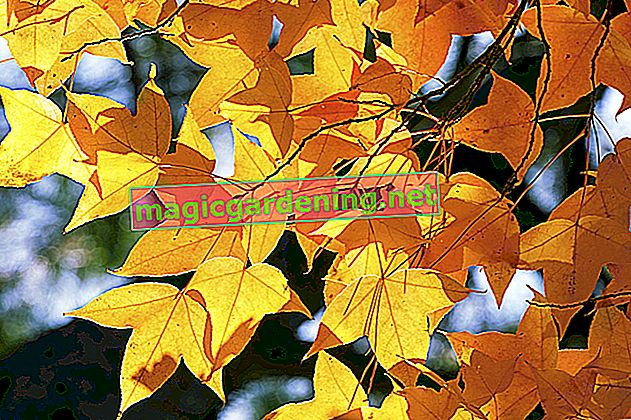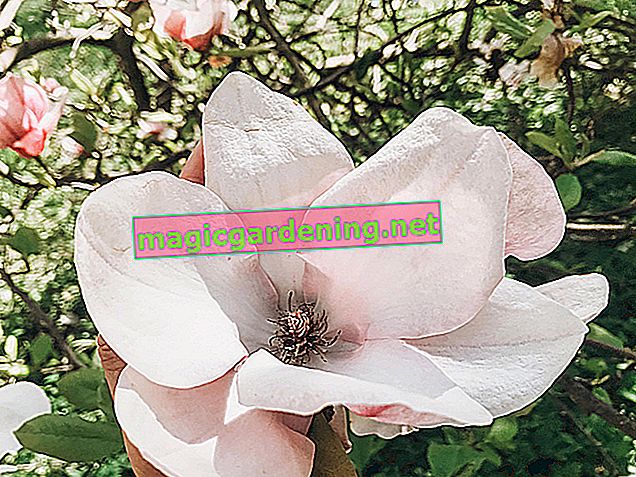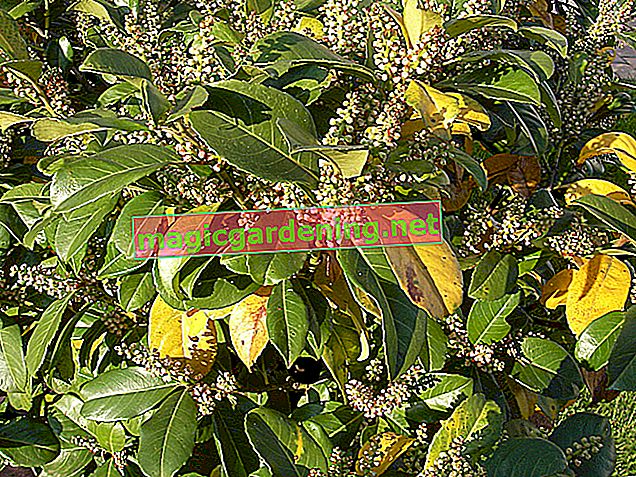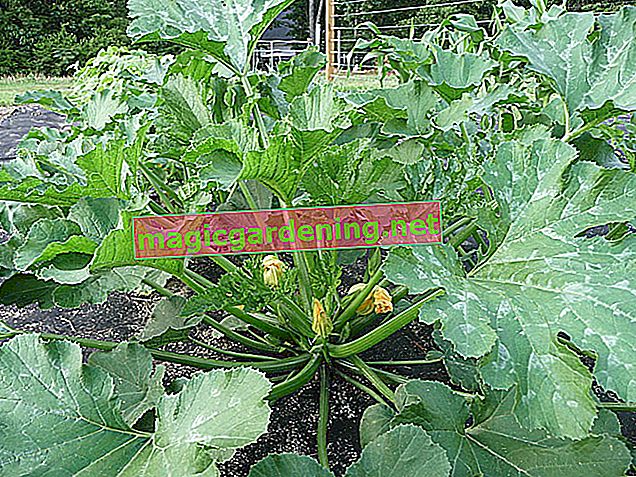
Origin and Distribution
The American sweetgum tree has its home in North and Central America, where it is primarily at home in river valleys and on mountain slopes between the state of New York and the Central American state of Nicaragua - provided the subsoil there is rich in nutrients, deep and rather fresh to moist.
also read
- The sweetgum tree: poisonous or harmless?
- Cutting the sweetgum tree: timing, necessity and more
- Sweetgum tree - a location for life
The species belongs to the genus of sweetgum trees (Liquidambar), which used to be part of the witch hazel family (Hamamelidaceae). In the meantime, however, botanists are of the opinion that the group forms its own very small plant family, the Altingiaceae, with only about 15 species. Amber trees are therefore not only native to North America, some species also thrive in the Mediterranean area (oriental sweetgum, Liquidambar orientalis) as well as in East and Southeast Asia (for example the Formosa sweetgum, Liquidambar formosana).
In Europe, however, the American sweetgum is cultivated as an ornamental and park tree. The species came to the Old World as early as 1681, and many varieties are now available in different sizes and heights.
use
While the American sweetgum tree is mainly cultivated as an ornamental tree in private gardens and in public parks, it is a valuable useful wood in its homeland. Not only is the sweet-smelling Storax, as the resin of the species is also known, an important raw material for the production of chewing gum and is used in natural medicine, the hard wood of the sweetgum tree, which is very similar in grain and color to walnut wood, is also very popular in furniture manufacturing.
In addition, the aromatic sweet gum and its resin are used as raw materials for the production of perfumes, soaps and other cosmetics. Although the resin of the tree is called “Storax”, the sweetgum tree is in no way related to the actual Storax tree (Styrax americanus) - only it replaced it as early as the 18th century in the extraction of resin.
Appearance and stature
In their homeland, wild specimens of the sweetgum tree reach heights of up to 45 meters. This makes the species one of the tallest growing deciduous trees, but in Central Europe it usually does not exceed about 20 meters even in climatically mild regions. In addition to the tall species, there are a number of significantly smaller varieties available that reach heights between around four and a maximum of ten meters and are therefore also suitable as house trees in private gardens.
At a young age, the sweetgum tree has a conical, rather narrow growth, but can grow broadly with increasing age. The initially red-brown bark later turns gray-brown and develops wide furrows as well as the cork strips characteristic of the species.
leaves
The sweetgum tree bears another name, which it owes to its maple-like leaves: it is called the starfish tree because the five- to seven-lobed, hand-shaped leaves are strongly reminiscent of the sea creatures. Laypeople often confuse the sweetgum tree with the native maple due to the shape of its leaves.
During the summer months, the alternately arranged leaves, which are up to 15 centimeters long, are glossy green, but often take on their wonderful autumn colors from the end of September. In the case of the sweetgum tree, nature seems to reach particularly deep into the color pot, because the color palette ranges from yellow-orange to orange-red and carmine red to purple tones. This broad coloration can often even be observed on the same tree.
The American sweetgum is one of the garden trees with the most beautiful autumn leaves, which is also the main reason for its popularity as a house and ornamental tree. Incidentally, the leaves also give off their characteristic aromatic scent when you rub them gently between your fingers.
Continue reading
Flowering and flowering period
The rather inconspicuous blossom of the sweetgum tree appears in the merry month of May. The species is monoecious, develops both female and male flowers on the same plant. Male flowers resemble upright, greenish spikes and are about five to seven centimeters long. The female inflorescences, however, sit on chestnut-like, hanging balls. Pollination takes place via insects.
fruit
At first glance, the spherical fruits of the sweetgum tree with long spikes resemble the fruit capsules of the sweet chestnut. However, with a diameter of two to three centimeters, they are significantly smaller, and they are made up of numerous woody capsules. Amber trees do not develop fruits until they are around 20 years old. These stick to the tree for a long time and often do not fall to the ground until spring.
On the ground, the brown fruit bursts open so that the small seeds fall straight to the ground. However, most of them cannot germinate and therefore cannot be used for reproduction. You can recognize the sterile seeds by the fact that they are noticeably small and rather angular in shape. Only a few seeds are fertile and therefore germinable. They are significantly larger, elliptical in shape and have membranous wings, with the help of which the wind carries them to possible new locations.
Continue reading
Toxicity
Although the resin of the sweetgum tree is still an important raw material for the production of natural medicines and chewing gum, it is only safe after its industrial processing. Otherwise, all parts of the plant apply to humans as well as animals as skin and mucous membranes irritating to poisonous, whereby symptoms of poisoning can occur especially in children and smaller pets.
Which location is suitable?
As in its natural locations, a sweetgum tree cultivated in the garden also needs a location in full sun and as warm as possible. It is best to plant the sapling in a place protected from wind and rain in front of a light house wall or wall, which is also ideally facing south. Here the tree gets enough sun and protection, which it needs especially in the first few years - the species only develops its frost resistance with increasing age. Wind protection is also important because the sweetgum tree loses its protective leaves very early in the year.
In contrast, a place is usually too dark, even in a partially or lightly shaded location. The species only develops its colorful autumn leaves in very sunny and warm locations.
Continue reading
ground
The ideal soil for the American sweetgum tree is deep, loose and well-drained, moderately nutrient-rich to humus and fresh. At best, you put it in loamy soil, because the species does not tolerate lean sandy soils as well as calcareous soils. While the sweetgum tree grows very slowly on sand, it quickly develops unhealthy yellow leaves on limestone soil. Waterlogging, in turn, leads to rot and thus to the death of the tree.
Pot culture
Since the sweetgum tree is very sensitive to cold, wind and other weather conditions in the first few years, you should first cultivate it in a large container and gradually get used to the climatic conditions. In the long run, however, the tall species cannot be kept in a planter without you having to severely restrict its growth. Amber trees grown as bonsai, for example, require a lot of attention and care.
Plant sweetgum properly
Plant the sweetgum tree as follows:
- Dig a planting hole.
- This should be twice as wide and deep as the root ball.
- Loosen the soil on the sides and bottom of the hole.
- Mix the excavated material with compost and horn shavings (€ 6.39 at Amazon *) / horn meal.
- If the soil is heavy, install drainage, for example through pebbles.
- Insert the tree so deep that the grafting point is covered with earth.
- Plant a support stake.
- Connect this securely to the trunk, e.g. B. with a bast ribbon.
- Fill in the planting hole and carefully tread on the soil.
- Sludge the fresh soil with plenty of water.
- Mulch the root disc to prevent the soil from drying out.
Continue reading
What is the best time to plant?
Basically, the sweetgum tree can be planted both in early autumn and in late spring. However, since young specimens in particular are quite sensitive to cold and wind, you should prefer spring.
Continue reading
The correct planting distance
As the sweetgum trees can grow up to 20 meters high and eight meters wide when fully grown, they need a lot of space. Therefore, the species is only suitable for a solitary position in the garden that meets these requirements - especially since transplanting in later years becomes difficult or even impossible. Furthermore, the sweetgum tree is very well tolerated by pruning, but depending on the variety, it is also quite fast-growing and therefore difficult to limit in height and width with secateurs.
Underplants
Amber trees show loose growth and let a lot of light through their crown. Therefore, they can be well planted under with ground cover and other perennials, provided that they do not compete too strongly. Onion flowers blooming in spring such as tulips and daffodils, but also monkshood, autumn anemones, forest bluebells and hostas are very suitable.
Watering sweetgum
Specimens cultivated in pots must of course be watered regularly during the growing season, as they cannot take care of themselves. Even freshly planted and young sweetgum trees can be given a swing from the watering can in dry weather. Older, well-established trees, on the other hand, can do without additional watering.
Fertilize sweetgum properly
The same applies to the supply of fertilizer: only young trees benefit from spring fertilization with compost and horn shavings to accelerate their slow growth. With older, well-rooted sweetgum trees, however, an additional supply of nutrients is not necessary.
Continue reading
Cut sweetgum properly
Amber trees are very pruning and can therefore be kept as a bonsai or as a pot culture for a few years. In contrast to fruit trees, however, regular maintenance or care pruning is basically unnecessary, and such a measure affects the natural growth form. It is therefore best to simply let the tree grow and only remove dead, diseased and too dense wood in the spring.
Continue reading
Propagate sweetgum
As a rule, sweetgum trees are propagated by grafting, but they can also be grown from seeds. In contrast to grafted specimens, however, seedlings are unpredictable in their properties, and only a few of the mature seeds are actually capable of germination. Only choose large, elliptically shaped seeds for sowing.
These need a cold stimulus so that the germ inhibition is broken. You should therefore store the seeds for about two months in the vegetable drawer of the refrigerator or sow them in a covered cold frame in autumn. From spring onwards, the seeds need constant temperatures from 20 ° C for germination and growth.
Continue reading
How do I transplant properly?
Once planted, sweetgum trees should only be transplanted within the first three to a maximum of five years. After that, they usually do not tolerate a change of location very well.
Diseases and pests
Diseases and pest infestation are very rare in the sweetgum tree. On the other hand, typical location and maintenance errors, such as these, are more common
- in places that are too dark
- compacted or otherwise unsuitable soil
- if it is too dry
- if there is insufficient fertilization
- as well as waterlogging
occur. Affected trees develop yellow to brown leaves that are shed after a while. In addition, they only grow very poorly. Since sweetgum trees are very sensitive, they can die off quickly, especially if there is too little / too much water.
Overwinter
Only the American sweetgum tree is sufficiently hardy in Central Europe, both the Oriental and the Asian Formosa sweetgum trees come from mild winter climates and are therefore not tolerant of frost. However, the American relative only develops its frost resistance with increasing age, which is why some experts recommend a bucket culture and gradual hardening at least for young trees. Later, when the tree has been planted, it is given winter protection in the first few winters. To do this, cover the root area with brushwood, mulch (€ 213.00 at Amazon *) or straw and wrap the trunk with garden fleece at temperatures below zero. Later, however, the tree develops sufficient frost hardiness.
Tips
The leaves that are thrown off in autumn are best left lying around: They not only serve as natural winter protection, but also provide the tree with valuable nutrients during the rotting process.
Species and varieties
Only the American sweetgum tree (Liquidambar styraciflua) is hardy in this country and can withstand temperatures of down to minus 24 ° C in protected locations. Some beautiful varieties of this species are now available that are wonderfully suitable for the home garden:
- 'Gumball': slow growing variety with a maximum height of two meters and a spherical crown
- 'Oktoberglut': very popular variety with bright, colorful autumn colors and a maximum height of three meters
- 'Variegata': variegated white foliage, maximum height of two meters, perfect for long-term keeping in pots
- 'Worplesdon': slow growth, up to a height of ten meters, fiery red autumn color
- 'Silver King': also variegated white foliage, bright red autumn colors, maximum height of five meters
- 'Slender Silhouette': slim column shape with a maximum width of one meter, wonderful for small gardens
Other types of sweetgum such as the Chinese sweetgum (Liquidambar acalycina), the oriental sweetgum (Liquidambar orientalis) or the Taiwanese sweetgum (Liquidambar formosana), on the other hand, are not suitable for planting in Central European gardens, but can be used in sufficiently large pots and with much more carefully Care in winter gardens or outside during the summer months.
 Garden painting 1000 year old tree with studio quality 89.99 EUR Buy from Pötschke
Garden painting 1000 year old tree with studio quality 89.99 EUR Buy from Pötschke  Garden painting 1000 year old tree 130 x 70 cm 69.99 EUR Buy from Pötschke
Garden painting 1000 year old tree 130 x 70 cm 69.99 EUR Buy from Pötschke  Garden painting 1000 year tree 70 x 50 cm 39.99 EUR Buy from Pötschke
Garden painting 1000 year tree 70 x 50 cm 39.99 EUR Buy from Pötschke








